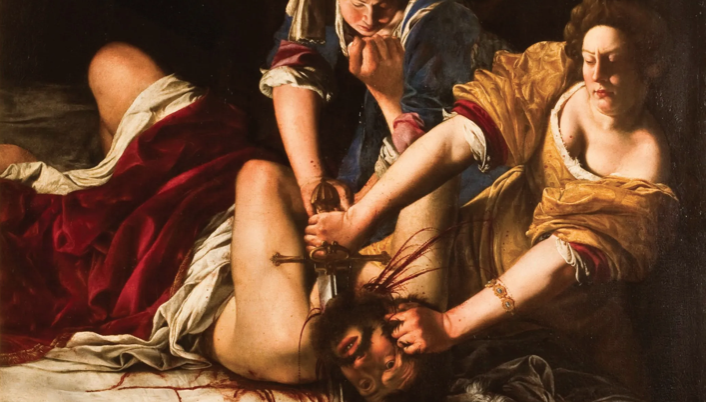by
_____
At the Wadsworth Atheneum in Hartford, a stunning exhibit celebrates the painter Artemisia Gentileschi and other female Italian painters.
“By Her Hand: Artemisia Gentileschi and Women Artists in Italy 1500-1800” presents a constellation of women artists from the Italian Renaissance and Baroque periods. But the star of the show is Gentileschi, considered by many to be Italy’s greatest female painter.
She achieved great fame in her lifetime, then her reputation faded for three hundred years.
In the 1970s, scholars began to reassess her work, seeing new meaning in her portrayal of strong women in scenes of tense psychological drama, with vivid, even shocking depictions of violence.
But Gentileschi should also be celebrated for her powerful public voice.

In 1611, she was raped by a fellow artist, Agostino Tassi. She was 17, and her attacker was more than twice her age.
Her father made a public accusation of rape, a ploy to force Tassi to marry his daughter. That led to a lengthy trial heard in the Pope’s own court in Rome, the Curia.
It was the trial of the century, with revelations that shocked and scandalized the Vatican and high society.
The transcript, housed today at the Archivio di Stato di Roma, includes graphic testimony by the 18-year-old Gentileschi.
What’s remarkable is the way her personality, her spirit, her resolve and self respect comes through in her words.
Note that some scholars have argued that the meaning of sexual assault in the 17th century was not the same as it is today. A violated woman would probably have understood the offense more as a form of social dishonor rather than a physical or bodily violation.
Regardless, what Gentileschi endured was horrific. She was required to undergo an exam by a midwife, to make sure she was no longer a virgin.
In her lengthy testimony, she described the assault in detail, how she tried to push Tassi away and even tried to stab him with a knife.
“He then threw me onto the edge of the bed, pushing me with a hand on my breast. And he put a knee between my thighs to prevent me from closing them,” reads a translation provided by Mary Garrard in her 1989 book, Artemisia Gentileschi: The Images of the Female Hero in Italian Baroque Art.
“I scratched his face and pulled his hair and, before he penetrated me again, I grasped his penis so tight that I even removed a piece of flesh.”

A judge asked whether Gentileschi would stand by her story under torture — “to remove all infamy or doubt about her person or words,” as he put it. To which Gentileschi replied: “My lord, I am ready to confirm my statement under torture and whatever must be done.”
On May 14, 1612, she was taken to Tassi’s cell and asked to repeat her claim of rape to his face, which she did. He denied it.
With Tassi watching, a device called a “sibille” — made of metal and rope — was wrapped around her fingers and tightened bit by bit, like thumbscrews.
“I have told the truth and always will because it is true,” she said, and as the cords were pulled tighter, she cried: “E vero, e vero, e vero, e vero.” (“It is true, it is true, it is true.”)
“I have told the truth, and always will,” she cried out. “E vero, e vero, e vero, e vero.”
In the end, Tassi was found guilty. But he didn’t marry Artemisia because it emerged during the trial that he was already married to someone else.
Gentileschi eventually went on to wed another painter — scholars suspect it was a marriage of convenience. The couple separated after a decade together. Of their five children, four died in infancy or childhood.
But she went on to lead an extraordinarily productive life as a painter, with commissions from wealthy elites, including nobles and royalty.
She was recognized as one of the most accomplished artists of her time, and in July 1616, she became the first woman admitted to the Accademia delle Arti del Disegno in Florence. She died in 1656, mostly likely when a plague swept through Naples.

Gentileschi’s work lives on, as do her words.
Today we have a much greater appreciation for the cost of sexual violence — and the pain inflicted on victims when they are forced to relive their trauma. That’s what makes Gentileschi’s 17th century testimony about her rape so astonishing. Her words are bold, unashamed, and self assured:
“I have told the truth and always will. E vero, e vero, e vero, e vero.”
© Copyright 2021
________________________________
Want to talk? Reach me at dana@danarubin.com

